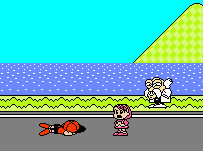Kenji Eno
Feel the different culture
on the backside of the Earth

COREgaming
- 21 / 08 / 08
I. HOPE
In spite of a very prolonged absence, the name Kenji Eno remains synonymous to pure videogame myth. His creations as an independent and multifaced designer have acquired a cult status among japanese and western videogame players who still refer to him as an irreverent and non-conformist author. Such enduring prominence in the bosom of an ever-changing industry, however, was conquered at the cost of the hard and sometimes single-handed work, spanning from the early nineties to the very dawn of this new millennium.
At the young age of 17, Eno abandoned his High school studies, a radical decision which stained his reputation in the eyes of his gossiping neighbors. For a time he lived a free life, travelling and searching for new life experiences until he finally felt motivated to find a job in the highly competitive and traditional Japanese market.
After several failed attempts to find an area where he could remain stable and active, Eno found a new way in the lower sectors of videogame production. Fascinated by the alluring and dangerous world of arcade parlors from an early age, videogames seem like a promising perspective. Because he couldn’t afford a synthesizer, Eno, who became a great fan of the electropop moods from Yellow Magic Orchestra, taught himself to use his computer as a musical production tool. Making use of this acquired knowledge, he was able to win the first prize in an amateur videogame creators contest: his trophy would later prove very useful as a lever to enter the professional world of videogame production, namely in the small studio Interlink, where he would develop new skills in using modern development tools.
In 1989, he gathered enough conditions to found his first independent studio: EIM, or Entertainment Imagination and Magnificence, was Eno’s escape plan from his former studio by the time it expanded into a larger and less personal group. While the idea of creating an autonomous new company was a step further, creating even better software for the Famicom console, it would later prove to be one of the most straining and unpleasant moments of his professional career.
At the time, the market often dictated that videogames should be created around popular characters, as a way to secure enough profits and return the investment. More than the supported production costs for the game program and the cartridges, creating games for Nintendo also included software protection policies which had to be covered by the studios in order to make theirs an official Nintendo product, worthy of their guarantee. Such inexorable impositions created in Eno a feeling of distress and irritation and eventually led him to shut down EIM, after the release of ten titles in the time span of three years.
Pre WARP (highlights)
SD Hero Soukessen
Before founding EIM, Eno helped producing Banpresto's first conversion of the popular anime series Gundam, in a japanese exclusive platforming game. Time Zone (1991, Famicom)
Time Zone was a textbook platform game where the boy hero sought to rescue the kidnaped girlfriend from the evil villain who, as demonstrated by the image above, bears significant resemblances to Megaman's counterpart Dr. Willy. Panic Restaurant (1993, Famicom/NES)
Also a platformer, Panic Restaurant had a unique feel to it: the character, a cook, had to push his way through hordes of nutrient enemies, using nothing but his trustworthy kitchen utensiles. |




